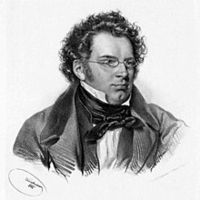Franz Schubert (31.01.1797–19.11.1828)
Franz Schubert was an Austrian composer who never travelled to Leipzig in person, but who was connected to the city through his publishers.

1. Biography
Franz Peter Schubert was born January 31st, 1797 as the twelfth of fourteen children of Franz Theodor Schubert, a teacher and schoolmaster and his wife Elisabeth, a former cook. He had to experience the deaths of his siblings several times – nine of his brothers and sisters didn’t survive their childhood years. At the age of six he started school and received his first piano lessons from his older brother Ignaz. His father played music with his sons as well, such as classical string quartets, so that Franz Schubert was raised in a musical environment. At the age of eight his father took over the music lessons, teaching his son music theory and to play the violin, recognizing and fostering his son’s talent. Schubert composed his first string quartet at age 13. Later he was trained by Michael Holzer, musical director of the parish church in Lichtenthal, Vienna, to play the organ, to sing and in basso continuo. Schubert joined the choir and sang some solo parts. During this period Schubert’s need to express himself artistically surfaced, resulting in compositions such as the Fantasie in G-Dur zu vier Händen (Fantasy in G-major for four hands) as well as songs to texts by Friedrich Gottlieb Klopstock and Friedrich von Matthisson, among others.
In 1808 Schubert passed the entrance examination for a choir scholarship at the Stadtkonvikt imperial seminary and lived as a choir boy in this Vienna boarding school for the next five years. Court organist Wenzel Ruzicka trained him in piano, viola and cello. During his time at the boarding school Schubert established several friendships which also became important for his artistic work later on, such as with Joseph von Spaun and Anton Holzapfel. Schubert’s initially good performance at school suffered after 1810, especially in Latin and mathematics. He rejected the renewal of his scholarship in 1813. During this time, he composed his first symphony.
Back with his parents he attended an institution for teacher training and became his father’s teaching assistant. Alongside his work he took lessons with Antonio Salieri, followed by a productive and creative compositional period. Soon this twofold pressure of teaching and composing became too much and Schubert tried to establish himself as a composer, but he had difficulties finding publishers who would take his compositions. In 1816 his application for a position as music director in Laibach was rejected. Eventually Joseph von Spaun introduced him to Franz Schober, who lent him his flat in Vienna, where Schubert could keep on composing. During this time, he met other poets, musicians and singers who wrote libretti for his works or introduced his compositions to their audiences in musical salons. By 1821 the so-called “Schubertiaden” were taking place in different flats and houses. Mainly Schubert himself played piano during those concerts and singers performed his songs. Sometimes readings and parlour games were added. Schubert’s friends helped to support him since he still didn’t earn any money with his music.
In 1818 count Johann Karl Esterházy appointed him as his singing master and pianist at his manor Zelis (today Želiezovce) in Hungary. Schubert returned to Vienna and his compositions in the same year. For the first time two of his operas premiered in 1820. Additionally, he was able to place some of his works with publisher Anton Diabelli.
In the following years Schubert’s health took a turn for the worse. At the end of 1822 he probably contracted syphilis. But not only his ill health overshadowed his work but also his inability to establish himself as a composer for operas. His two works Alfonso and Estrella as well as Die Verschworenen were rejected by the theatre.
While travelling to Upper Austria in 1825 Schubert started working on his Symphony in C major. He wanted to present his works outside of Vienna as well.
From 1826 to 1828 Schubert stayed in Vienna, where he applied for the position of assistant director of the court ensemble but was rejected. In 1827 he wrote his famous song cycle Die Winterreise.
Schubert’s health deteriorated rapidly and on November 19th, 1828 he died in the flat of his brother Ferdinand.
2. Private Life
Schubert’s childhood was dictated by his father’s strictness, who recognized his son’s talent and nurtured it, but who also saw Schubert in a white-collar job and forbade his son to compose when his school performance suffered. This conflict intensified until Schubert was banned from visiting his mother or siblings. Already at a young age he had to accept personal loss since some of his siblings died during his early childhood, and the death of his mother in 1812 also struck him hard even though it led to reconciliation with his father. “I received the news of my mother’s death. I hurried to see her and my father, softened by grief, did not hinder my entering. Then I saw her corpse. Tears streamed from my eyes.”1 This experience, death’s omnipresence within his family and the deep conflict between father and son strongly characterized Schubert’s attitude towards life and was reflected in his great compositional productivity.
Franz Schubert’s supposed homosexuality has been discussed quite often. Many have interpreted his close friendship to Franz von Schober and Johann Mayrhofer, with whom he also shared different flats, as love affairs. Nonetheless Schubert was described as a womanizer; he was believed to have a relationship with maid Pepi Pöcklhofer while he was in Zelis or with Comtesse Karoline Esterházy, who took piano lessons from him during his second stay in Hungary. Schubert’s illness constituted a heavy stroke of fate. At that time, it was considered a disgrace and Schubert felt impelled to keep his suffering a secret, which in return caused him to suffer mentally. He wrote to his friend Leopold Kupelwieser in 1824: “In a word, I feel that I am the unhappiest, most miserable human being in the world.”
1 Cited in: Korff, Malte: Franz Schubert, München 2003, p. 32.
3. Connection to Leipzig
In contrast to other composers of his time, Franz Schubert never visited Leipzig. But he was connected to the city through his publisher. Shortly before his death he was able to place his compositions with Breitkopf & Härtel. This publishing house also released a complete edition of his works in 1884. In 1839 Schubert’s music was performed for the first time in the Old Gewandhaus, which then still stood in Leipzig’s city centre. Felix Mendelssohn Bartholdy conducted his Symphony in C major. Schubert’s brother Ferdinand had sent the full score to Breitkopf & Härtel and told Mendelssohn about it.
On the occasion of the 100th anniversary of Schubert’s death the Leipziger Männerchor (Leipzig male choir), founded in 1891 and directed by Gustav Wohlgemuth, raised a monument for the composer. Since the city council denied its support, Leipzig’s citizenry financed the high stele near today’s Anton-Bruckner-Allee. The honorary committee of the monument consisted among others of the Gewandhaus’s music director Wilhelm Furtwängler and St. Thomas cantor Karl Straube. Leipzig resident, sculptor and painter Margarete Tschaplowitz-Seifert (1889–1977) designed the 3.8 m high monument, and built it out of three stacked granite blocks which form an isosceles triangle in cross-section. While modelling Schubert’s profile in relief, Tschaplowitz-Seifert closely followed the drawings of Moritz von Schwind, a painter and close friend of the composer.
4. Reception
Schubert was counted among the most famous as well as misunderstood composers of his time. Until the 20th century he was mainly perceived as a romantic song composer. But during the final decades the composer was newly appreciated on the basis of his comprehensive works including symphonies, masses, quartets and stage works, whose success was mainly denied during Schubert’s lifetime. But still Schubert was not only well known in Vienna. During the final years of his life publishers developed an interest for his works, among them Breitkopf & Härtel in Leipzig. Before his death he was able to publish about 100 of his compositions. The more people were able to gain access to Schubert’s works, e.g. through to the premiere of Die Unvollendeten in 1865 in Vienna, the more Schubert’s importance for the development of romantic music received awareness. His song cycles Die Winterreise and Die schöne Müllerin were of high importance for the development of the genre of art songs (Kunstlied). Especially in the 20th century they were edited, performed, reinterpreted and recorded countless times. Die Winterreise shows the great influence of Schubert’s works on other forms of art, such as Berthold Brecht’s drama Baal (1918), in which different aspects of the cycle are clearly visible, or in the theatre text Winterreise by Elfriede Jelinek written in 2011. In the visual arts Schubert and his work became a topic e.g. for Jewish painter Charlotte Salomon in her cycle of pictures Life? Or Theatre? A Musical Comedy (1940-1942), which she painted during her time of exile in Southern France and which refers to music again and again – by Johann Sebastian Bach, Wolfgang Amadeus Mozart or Franz Schubert. Shortly before her death she painted a picture with the title Der Tod und das Mädchen (Death and the Maiden), which also is the name of one of Schubert’s most famous string quartets. Schubert also influenced other musicians in the area of instrumental music. For example, he allocated more importance to smaller musical forms within his compositions, which was continued by other composers such as Mendelssohn and Schumann and later also by composers of the 20th century.
5. Works
The Austrian Academy of Sciences names more than 1000 handwritten and printed sources of Schubert. In accordance with the Deutsch-Verzeichnis (catalogue by musicologist Otto Erich Deutsch) all of Schubert’s compositions are marked with the abbreviation D. The first complete edition of his works was published by Breitkopf & Härtel in 1884. Today the Bärenreiter publishing house is working on a new complete edition. The extent and diversity of Schubert’s work is striking, especially with regard to his short life span.
Sacred Music
Six Latin Masses
German Mass
Two Stabat Maters
Four Offertories
Stage Works (selection)
Des Teufels Lustschloss - Natürliche Zauberoper (1813/14, D 84): Opera (premiere Hans Otto Theatre, Potsdam 1978)
Der vierjährige Posten (1815, D 190): Singspiel (premiere Hofoper, Dresden 1896)
Alfonso und Estrella - Grosse heroisch-romantische Oper (1821/22, D 732): Opera (premiere Hoftheater, Weimar 1854)
Die Verschworenen (1823, D 787): Singspiel (premiere Stadttheater Frankfurt in the Comoedienhaus at Rossmarkt 1861)
Songs
Approx. 600 songs (selection)
the cycles Die schöne Müllerin and Winterreise
the song collection Schwanengesang
the cycle Fräulein vom See
Orchestral Works
12 symphonies (of which 5 are unfinished), overtures, one orchestral work, one concert piece, one rondo and one polonaise.
Furthermore, a number of songs for choir or several voices, chamber music and piano music.
Audio Samples
Winterreise (1827) www.youtube.com/watch
Große Sinfonie in C-Dur (1825) www.youtube.com/watch
Schubert vertonte für den Wiener Synagogal Chor auf Wunsch von Salomon Salzer den 92. Psalm (1828)
www.youtube.com/watch
6. Sources and Links
Korff, Malte: Franz Schubert, Deutscher Taschenbuch Verlag 2003.
Walther Dürr/Michael Kube, Art. Schubert (Wien) in: MGG Online, ed. by Laurenz Lütteken, Kassel, Stuttgart, New York 2016ff., first published 2006, published online 2016,
https://www.deutsche-schubert-gesellschaft.de/, 29 May 2020
Werner Aderhold, Walther Dürr, Walburga Litschauer (ed.): Franz Schubert – Jahre der Krise 1818 bis 1823. (Festschrift Arnold Feil.), Bärenreiter 1985.
Photo
Josef Kriehuber - http://www.portraitindex.de/documents/obj/oai:baa.onb.at:3497549 - gemeinfrei




